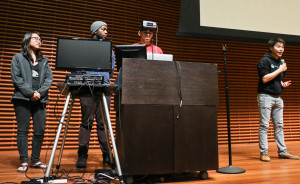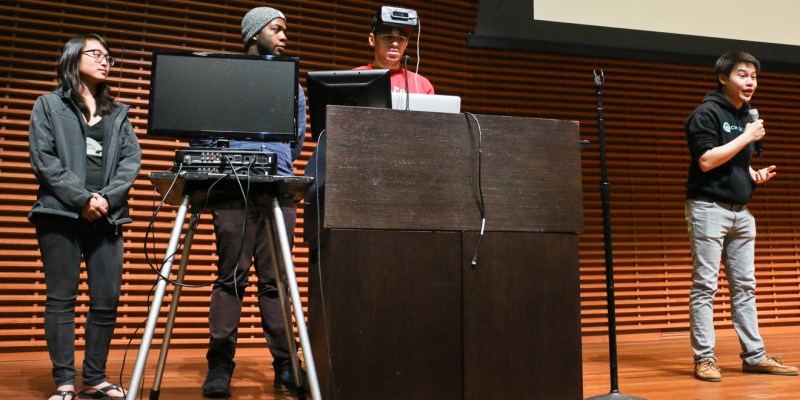
The Frances C. Arrillaga Alumni Center was bustling with activity throughout the weekend of Feb. 20 to Feb. 22, with over 670 programmers from across the nation creating hacks in the allocated 36-hour time frame.
Hosted by the Business Association of Stanford Entrepreneurial Students (BASES) HackSpace, the event was Stanford’s first large-scale, intercollegiate hackathon and was sponsored by a wide variety of tech companies, including Microsoft, Apple, Facebook and Dropbox. These sponsors provided funding and prizes to participants as well as access to industry professionals as mentors.
TreeHacks co-directors Russell Kaplan ’17, Rishi Bedi ’17 and Jason Teplitz ’17 spoke about how they focused on providing a uniquely Stanford experience and on making the event accessible for participants of different skill levels.
Providing a Stanford experience
Hackathon attendees had the opportunity to participate in and attend a variety of events, like a performance by the Leland Stanford Junior University Marching Band, Frisbee, massages and yoga workshops, when taking breaks from hacking. Some of these events were organized by the directors, while others were coordinated by companies — like Microsoft, which arranged for masseuses to be present for four hours.
“A high point of TreeHacks was when everyone was outside and hungry on Saturday night, waiting for Ike’s,” Kaplan said. “Then the Stanford Band ran through and performed, and nobody had any idea they were coming. The energy was infectious.”
“Hackathons have lots of common elements across schools, but I don’t think anyone’s ever seen anything like that at a hackathon,” he added. “For us it was awesome because [the Band is] just such a core part of Stanford and made this hackathon uniquely Stanford.”
According to the organizers, they also focused on creating a non-cutthroat environment for the hackathon. Kaplan highlighted the lack of cash prizes as a key factor in the collaborative atmosphere of TreeHacks.
“The vibe of [a] hackathon is different depending on what is incentivized,” Kaplan said. “We wanted to give people an excuse to come together and have a creative outlet to build amazing things. When hackathons offer large cash prizes, there is a lot of pressure, and the vibe is different. We gave awesome prizes, but they were experience-based rather than monetary.”
Accessible across skill levels
Implementing a mentorship program through which participants could seek assistance from industry professionals was a key component in making TreeHacks accessible across all experience levels. Over 150 help tickets were filed and closed over the course of the weekend.
“With the mentorship program, we had that goal that whether you had a specific question or if you needed help very broadly to figure out what to do, you could just ask that and not feel uncomfortable,” Bedi said.
Having mentors readily available made the hacking process easier for some participants. Jessica Gu, a junior from UC-Berkeley, created a chat system inspired by the Unix command “cowsay” with the help of the mentors.
“They gave us a lot of help through the mentor system,” she said. “So I was able to ask a lot of questions because I did not know much about web stuff. That’s how it all came together.”
Hackathon veteran Michael Copley, a junior from the University of Michigan, also utilized the access to mentors at Stanford’s hackathon.
“The mentors had a lot of experience integrating things into applications,” Copley said. “Normally something that would take me two to three hours to integrate took 20 to 30 minutes with their help.”
In addition to having mentors available during the event, the co-directors organized HackWeek, a series of workshops during the week leading up to the event, to ease inexperienced participants into the hacking culture. Students or faculty members covered a different topic each day.
“People spend a lot of time in CS classes building programs, but you have starter code and can fill in functions,” Kaplan said. “In hackathons you have no starter code, just your computer and an empty screen, and you are tasked with building something. With the workshops, we tried to bridge the gap there.”
A diverse turnout
Funding from the sponsors provided money for travel reimbursements that allowed hackers across the nation to attend the hackathon.
“We were able to offer travel reimbursements to basically fill the room with as many incredible people as we could find,” Kaplan said.
Princeton undergraduates Prem Nair and Nathan Lam were flown across the country to attend TreeHacks. Lam appreciated that TreeHacks allowed him to interact with the hacking community.
“At events like these, you meet a lot cool of people. The hacking culture is really strong. You get to see a lot of friends and it’s almost a reunion,” he said. “You see the same people at hackathons across the nation. It really is a community.”
Teplitz also appreciated the Stanford turnout at TreeHacks. Two of the top eight teams, in addition to half of the members on the second-place team, were from Stanford.
“We initially weren’t quite sure if we would get a lot of excitement from Stanford students, but there were a number of students that came and a number of amazing Stanford projects,” Teplitz said.
369 Stanford students participated in TreeHacks, including Catherina Xu ’18 and Kristen Law ’18. Xu and Law developed an application called Wake Me Up that wakes a user who has fallen asleep on public transportation but is nearing her destination. The app won a Dropbox Engineering Prize.
For Xu, the most valuable aspect of TreeHacks was seeing the accomplishments of her peers.
“It’s also great seeing what people you know build amazing things, and you can talk to them on a personal level about what they did,” Xu said.
In their vision for the future of TreeHacks, the co-directors want to expand the event to have enough space for more people. They also hope to make TreeHacks even more accessible to inexperienced programmers through more specialized introductory workshops.
“Mentorship relies on people initially reaching out who have questions. But for people who had no experience on a certain platform, it’s not that helpful,” Bedi said. “It would be nice to have very basic introduction workshops during the event for people who have never hacked or used a certain platform before.”
Contact Pallavi Krishnarao at pallavik ‘at’ stanford.edu.
